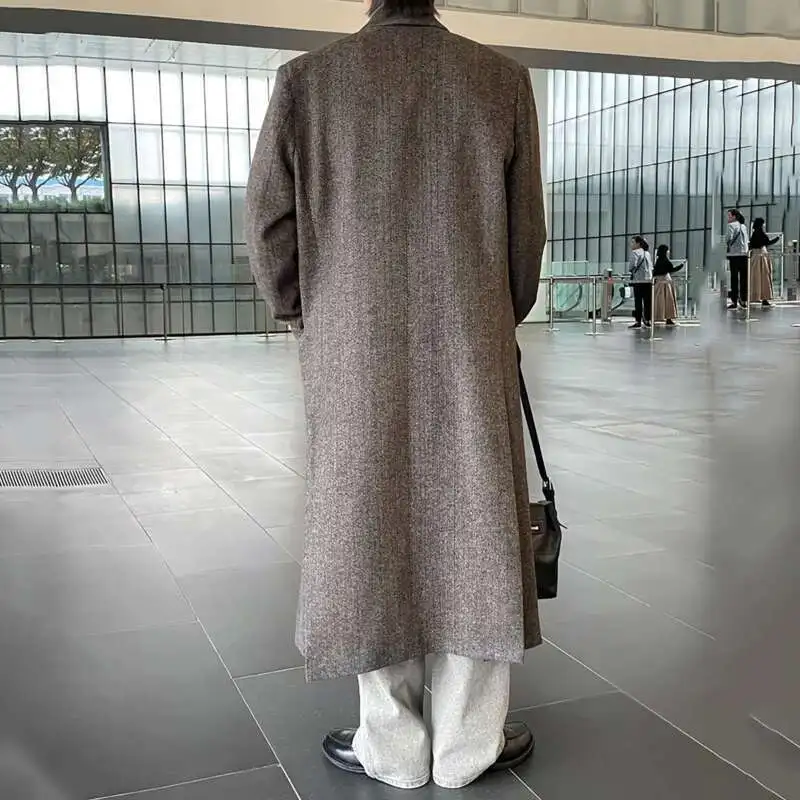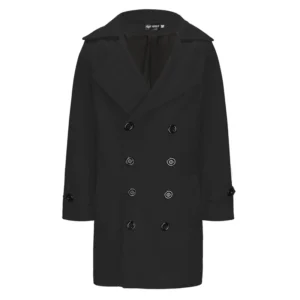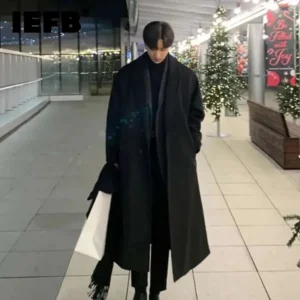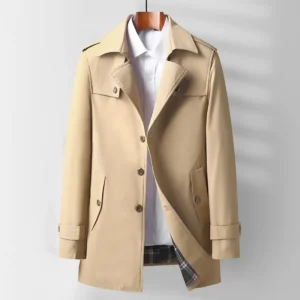What Defines the Herringbone Pattern in Men’s Coats?
The herringbone pattern stands as one of menswear’s most distinctive and sophisticated textile designs. At its core, herringbone is a broken twill weave that creates a characteristic zigzag pattern resembling a series of “V” shapes across the fabric. This isn’t merely a printed design—it’s woven directly into the fabric structure, creating both visual interest and textural depth that distinguishes quality outerwear.
The pattern derives its name from its uncanny resemblance to a herring fish skeleton, with rows of parallel lines slanting in opposite directions to create a repeating V-shaped pattern. This distinctive arrangement gives men’s herringbone coats their timeless appeal and immediately recognizable character.
While often confused with chevron, herringbone has a crucial distinguishing feature: where chevron maintains a continuous zigzag pattern, herringbone reverses direction at regular intervals, creating a broken zigzag effect. This subtle distinction gives herringbone its distinctive “broken” appearance that adds complexity and sophistication to the weave.
The scale of herringbone patterns can vary significantly, from fine, subtle patterns that appear almost uniform from a distance to bold, pronounced zigzags that make a stronger visual statement. Finer herringbone creates a more formal, refined appearance suitable for business settings, while larger patterns often feel more casual and rustic, especially in heavier fabrics.
What truly sets herringbone apart is not just its appearance but its tactile qualities. The weaving technique creates a subtle texture that adds dimension to the fabric, making it not just visually interesting but pleasantly tactile. This textural quality contributes significantly to the garment’s drape and character, giving herringbone coats their distinctive presence and weight.
The Historical Journey of Herringbone: From Ancient Origins to Modern Menswear
The herringbone pattern boasts a surprisingly ancient heritage that far predates its popularity in men’s fashion. Archaeological evidence reveals herringbone patterns in textiles from ancient Egypt dating back to 600 BCE, where the distinctive zigzag was used in cloth wrappings. Even more impressively, the Romans employed a herringbone arrangement in their road construction techniques, laying bricks in opposing diagonal patterns to create stable, durable pathways—many of which survive to this day.
Throughout medieval Europe, the herringbone weave gained popularity among textile artisans who recognized its structural advantages and visual appeal. The pattern created fabrics with greater strength and insulation properties than simple weaves, making it particularly valuable for outerwear in colder northern regions. By the Middle Ages, herringbone had become firmly established in European textile traditions.
Irish and Italian weavers deserve particular credit for elevating herringbone to prominence in men’s fashion. Irish weavers incorporated the pattern into hardy wool fabrics designed to withstand harsh weather conditions, while Italian craftsmen refined the technique for more luxurious applications. These traditions merged to create the tweed coat variations that would later become staples of gentlemen’s wardrobes.
The 19th century marked herringbone’s golden age in men’s tailoring. As the modern suit evolved, British tailors embraced herringbone for its visual sophistication and practical benefits. The pattern became particularly associated with British country clothing and aristocratic sporting attire, where it adorned everything from hunting jackets to formal overcoats. This association with the British upper classes lent herringbone an air of refinement and prestige that continues to influence its perception today.
By the early 20th century, herringbone had transcended its elite origins to become a mainstream feature in men’s fashion. Hollywood’s golden age further cemented its iconic status, with film stars like Cary Grant and Gregory Peck frequently appearing in perfectly tailored herringbone overcoats and suits. The pattern has experienced periodic resurgences in popularity ever since, with designers continually finding new ways to incorporate this ancient weave into contemporary fashion.
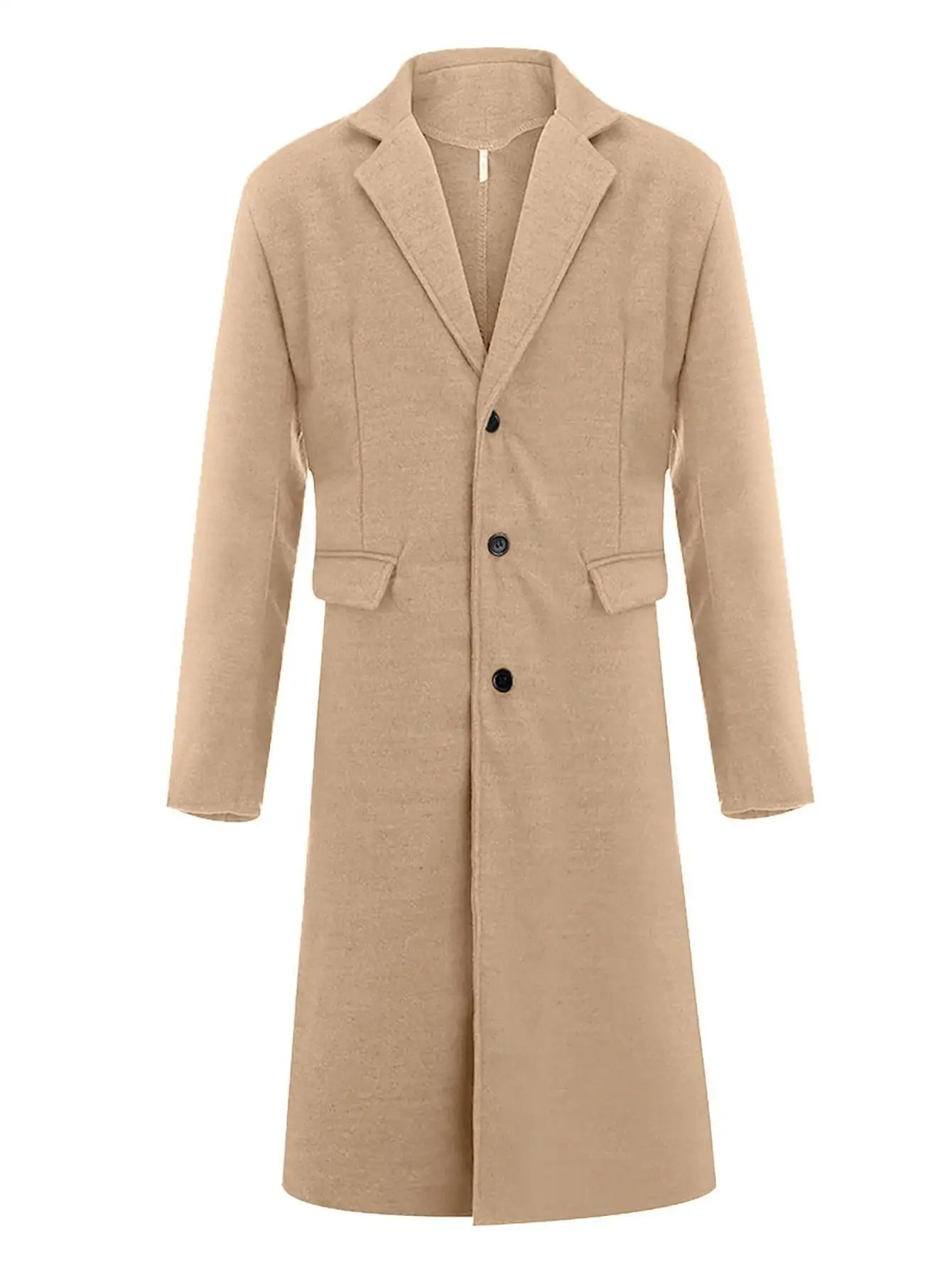
The Fabric Matrix: Materials and Construction of Herringbone Coats
The distinctive character of a herringbone coat stems largely from the materials used in its construction. Traditional herringbone coats typically feature natural fibers that enhance both the pattern’s visual impact and the garment’s functional properties.
Wool remains the quintessential choice for herringbone outerwear, with several varieties offering different qualities:
- Merino wool: Prized for its softness and fine texture, merino creates luxurious herringbone coats with excellent temperature regulation
- Lambswool: Slightly more robust than merino but still soft, offering excellent warmth and a more pronounced texture
- Harris Tweed: A protected type of Scottish handwoven wool featuring a distinctive coarse texture and exceptional durability, often used in heritage-style herringbone coats
- Shetland wool: Creates rustic, textured herringbone patterns with superior insulation properties
The weight of wool coats varies significantly, from heavy winter-weight fabrics (18-24 oz per yard) offering maximum protection against bitter cold to mid-weight options (12-16 oz) that provide versatility across seasons. The weight not only affects warmth but also how the herringbone pattern displays—heavier fabrics typically showcase bolder, more defined patterns.
Modern adaptations have expanded the herringbone universe beyond traditional wools. Cotton herringbone creates lighter options for transitional seasons, while linen variations offer breathable summer alternatives that maintain the pattern’s sophistication. Contemporary blends incorporating small percentages of synthetic fibers can improve wrinkle resistance and durability without sacrificing the natural character that makes wool overcoats so desirable.
The weaving process itself contributes significantly to the quality of a herringbone coat. The pattern emerges from a broken twill weave where weft threads pass over one or more warp threads, then under two or more, with the direction reversing at regular intervals. This technique creates not just visual interest but structural advantages. The interlocking nature of herringbone weaves produces fabrics with superior tensile strength, better resistance to tearing, and improved insulation properties compared to simpler weaves.
The choice of material directly impacts how a coat performs and ages. Pure wool herringbone naturally resists wrinkles, maintains shape excellently, and offers superior insulation even when damp. It also develops character over time, often looking better with age when properly maintained. Understanding the relationship between fabric choice and coat length can help achieve the perfect coat length for height and build, as different materials drape and hang differently on the body.
The Herringbone Coat Portfolio: Styles and Variations
The herringbone pattern adapts beautifully across various coat styles, each offering distinct aesthetic and functional benefits. Understanding these variations helps identify the perfect addition to your wardrobe within the broader men’s overcoats category.
The Classic Herringbone Overcoat
The quintessential herringbone garment remains the full-length overcoat. Typically extending to the knee or just below, this formal style projects authority and sophistication. The single-breasted version, with its clean lines and three or four-button front, offers versatile elegance appropriate for both business and formal occasions. In contrast, the double-breasted overcoat makes a bolder statement with its overlapping front panels and two parallel columns of buttons, creating a more dramatic silhouette that excels in formal settings and colder weather.
Classic herringbone overcoats typically feature notch or peak lapels, the latter adding additional formality and visual interest. Side pockets are often flapped for practicality and clean lines, while a breast pocket provides an opportunity for a pocket square to enhance the formal appearance.
The Herringbone Sport Coat and Blazer
For smart-casual versatility, the herringbone sport coat or blazer offers tremendous flexibility. Shorter than an overcoat and typically ending at the hip, these jackets work beautifully with everything from tailored trousers to dark denim. The pattern adds visual interest and texture to an otherwise simple outfit, making herringbone blazers especially valuable for creating sophisticated casual looks.
These jackets often feature more relaxed construction than formal overcoats, with natural shoulders, less canvassing, and sometimes patch pockets for a more casual appearance. The herringbone pattern helps disguise the more relaxed construction while maintaining a refined appearance.
The Herringbone Tweed Jacket
Drawing on British country heritage, the herringbone tweed jacket combines rustic charm with practical durability. These coats typically feature a sturdier, more textured fabric than their city counterparts, often incorporating flecks of color that add depth and character to the herringbone pattern. Traditional details might include leather buttons, elbow patches, and ticket pockets—all nods to the jacket’s sporting heritage.
The herringbone tweed jacket works exceptionally well in casual country settings but has also found a place in urban environments as a statement piece that bridges formal and casual dress codes.
The Herringbone Topcoat
For milder weather or transitional seasons, the herringbone topcoat offers a lighter alternative to the traditional overcoat. Typically falling to mid-thigh or just above the knee, these coats provide warmth without the bulk of heavier options. The lighter fabric allows for more fluidity in the silhouette, creating a modern, streamlined appearance even with the traditional herringbone pattern.
Understanding the proportions of different coat styles is crucial for finding the most flattering option. The men’s coat length guide provides valuable insights into how length affects both style and practicality across these different herringbone variations.
Other herringbone variations include the peacoat, with its characteristic short length and wide lapels; car coats designed for easier movement while driving; and even trench coats featuring water-resistant herringbone fabrics for rainy weather protection combined with pattern interest.
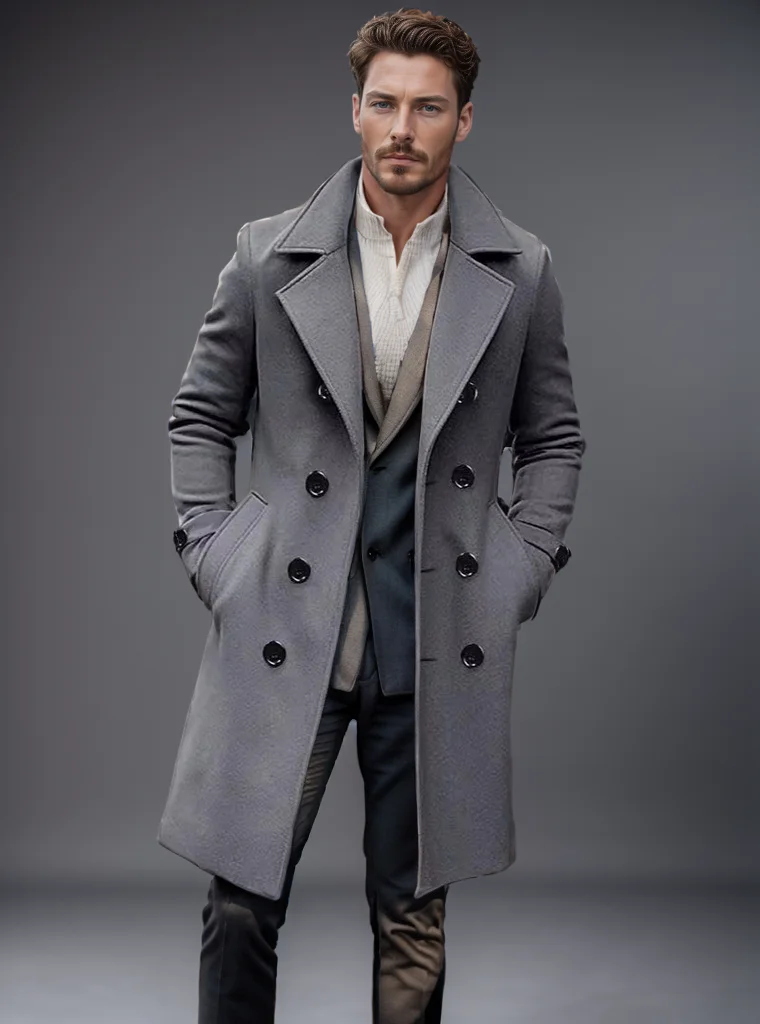
Mastering the Art: How to Style a Herringbone Coat
The versatility of herringbone makes it appropriate across the formality spectrum, from boardroom to weekend outings. Mastering how to style this classic pattern ensures you’ll maximize your coat’s versatility.
Formal Styling
For business and formal occasions, a herringbone overcoat serves as the perfect finishing touch to refined attire:
- Pair with solid navy, charcoal, or black suits for classic elegance that never feels overstated
- Choose spread or semi-spread collar shirts that complement the coat’s lapel width
- Select ties in solid colors or subtle patterns that don’t compete with the herringbone
- Consider accessories like leather gloves and cashmere scarves in complementary neutral tones
- Complete the look with polished Oxford or Derby shoes in black or dark brown
The formal approach works particularly well with dress coats featuring cleaner lines and more structured silhouettes. The herringbone pattern adds just enough visual interest without undermining the formal nature of the ensemble.
Business Casual Approach
For less formal work environments or smart-casual occasions, herringbone offers excellent flexibility:
- Combine with wool trousers or well-tailored chinos in complementary neutral shades
- Layer over merino or cashmere sweaters for added warmth and texture
- Consider open-collar dress shirts or fine-gauge turtlenecks underneath
- Accessories like knit ties, textured scarves, or subtle pocket squares add personality
- Brown brogues, Chelsea boots, or clean leather loafers provide appropriate footwear options
Understanding how coat length affects style is particularly important in business casual settings, where proportions can make the difference between looking thoughtfully dressed and feeling overdone.
Elevated Casual Looks
Even in casual settings, herringbone adds sophistication to relaxed attire:
- Pair with dark, well-fitted jeans and a quality sweater for effortless weekend elegance
- Layer over chambray shirts or casual button-downs for texture contrast
- Consider lightweight scarves or knit beanies as practical accessories that enhance the look
- Complete with suede Chelsea boots, desert boots, or clean sneakers in leather or suede
- For colder weather, experiment with layering a quilted vest or lightweight jacket underneath
The contrast between the structured formality of herringbone and more casual elements creates particularly interesting outfits. The differences between short and long coats become especially relevant in casual styling, where proportions dramatically affect the overall vibe.
Color Theory and Pattern Coordination
Traditional herringbone coats come in neutral colorways—most commonly grays, browns, and blues—that pair easily with most wardrobes. Some guidelines for effective color coordination:
- Gray herringbone works beautifully with navy, burgundy, forest green, and most other colors
- Brown herringbone pairs naturally with earth tones, blues, and dark greens
- Blue herringbone complements grays, browns, darker blues, and burgundy
- When mixing patterns, vary the scale—pair larger herringbone patterns with smaller checks or stripes
- Create depth by combining textures like smooth worsted wool, knits, and oxford cloth
Remember that the scale of the herringbone pattern affects styling choices—finer patterns read as more formal, while bolder ones have a more casual, statement-making quality.
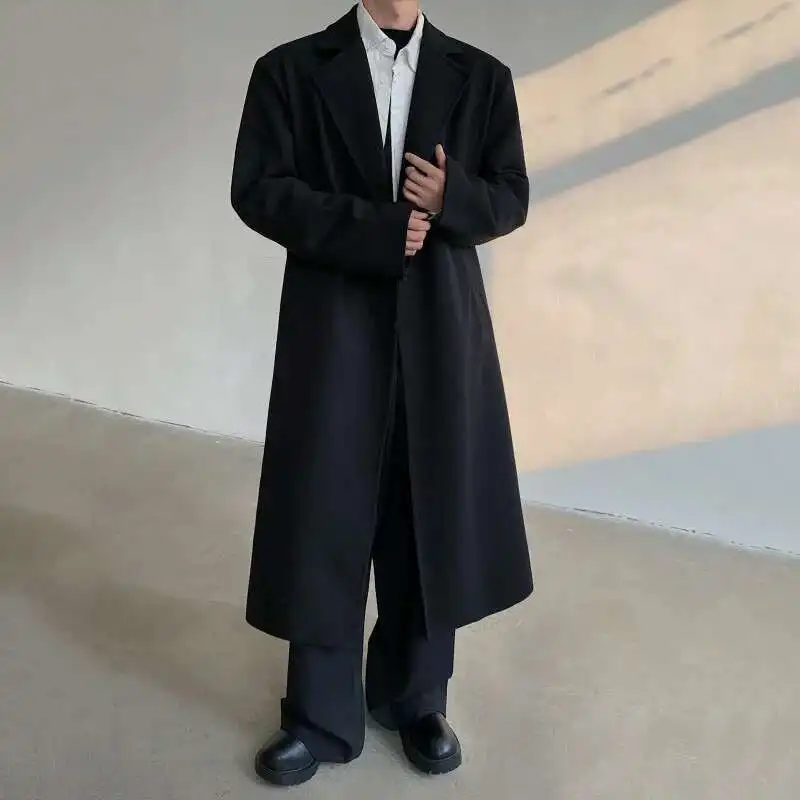
The Discerning Purchaser: A Guide to Selecting Quality Herringbone Coats
Investing in a quality herringbone coat requires attention to several key factors that determine both immediate satisfaction and long-term value.
Fit Considerations
The foundation of a great coat is proper fit, regardless of quality or price:
- Shoulders should align with your natural shoulder edge, neither extending beyond nor falling short
- With arms at your sides, you should be able to comfortably make a fist without sleeve restriction
- The chest should allow enough room for layering without excessive fabric when worn over a suit
- The coat should close comfortably without straining at the buttons or creating an “X” pull
- Length is crucial—finding the perfect coat length for every body type ensures proper proportion
- For shorter men, specific length considerations can make you appear taller when chosen correctly
Remember that alterations can address sleeve length and sometimes waist suppression, but shoulder fit and overall length are extremely difficult and expensive to modify.
Fabric Assessment
Quality fabric forms the cornerstone of a superior herringbone coat:
- Examine the material in good lighting, looking for clear pattern definition and even coloration
- Touch the fabric to assess softness, body, and resilience—quality wool springs back when pinched
- Higher thread counts generally indicate finer, more luxurious fabrics
- Pure wool (especially merino, lambswool, or cashmere blends) offers superior insulation and aging
- Fabric weight should match your climate needs—heavier weights (20-24 oz) for cold regions, medium weights (14-18 oz) for versatility
- Superior fabrics come from renowned mills in the UK, Italy, or Japan, often noted on interior labels
The weave quality directly impacts both appearance and longevity—tighter, more consistent herringbone patterns typically indicate higher-quality construction.
Construction Quality Markers
Several telltale signs distinguish superior coat construction:
- Examine interior lining—quality coats feature smooth, breathable linings (often Bemberg or silk) with clean seams
- Check stitching consistency, particularly on lapels and pockets—smaller, even stitches indicate quality
- Buttonholes should be neatly finished with no loose threads, ideally hand-stitched for premium coats
- Collar and lapels should lay flat against the body when worn
- Functional sleeve buttons (able to unbutton, known as “surgeon’s cuffs”) often indicate higher-quality tailoring
- Interior construction should include canvassing rather than fusing for better drape and longevity
Understanding proper coat length influences how these quality elements will present on your frame, making knowledge of ideal proportions essential to evaluating construction quality.
Price-to-Value Considerations
Quality herringbone coats span a wide price spectrum:
- Entry-level options ($200-400) may offer decent materials but often compromise on construction details
- Mid-range coats ($400-800) typically balance quality materials with solid construction
- Premium options ($800-1500) offer superior fabrics, construction, and details
- Luxury herringbone coats ($1500+) feature exceptional materials, hand-tailoring, and exclusive detailing
Value comes from matching your specific needs with appropriate quality levels—daily wear justifies investing in durability, while occasional formal wear might not require the highest-end options. Consider cost per wear rather than just the initial price tag when evaluating true value.
Mens Double Breasted Pea Coat, Mens Wool Blend Coat, Mens Wool Pea Coat
Price range: $136.84 through $157.36 Select options This product has multiple variants. The options may be chosen on the product pageMens Cashmere Overcoat, Mens Hooded Winter Coat, Mens Wool Blend Coat
Price range: $128.72 through $139.68 Select options This product has multiple variants. The options may be chosen on the product pageMens Black Overcoat, Mens Black Wool Coat, Mens Wool Overcoat
$339.18 Select options This product has multiple variants. The options may be chosen on the product pageMens Grey Overcoat, Mens Wool Blend Coat, Mens Wool Overcoat
$201.28 Select options This product has multiple variants. The options may be chosen on the product pageMens Herringbone Coat, Mens Long Overcoat, Mens Wool Overcoat
Price range: $197.16 through $203.69 Select options This product has multiple variants. The options may be chosen on the product pageMens Long Overcoat, Mens Topcoats
Price range: $189.40 through $196.88 Select options This product has multiple variants. The options may be chosen on the product page
For those appreciating heritage styles, vintage-inspired tweed coats offer particularly good value, combining traditional herringbone patterns with time-tested designs that resist fashion’s fluctuations.
Preservation Techniques: Caring for Your Herringbone Investment
Proper maintenance significantly extends the life of your herringbone coat, preserving both its appearance and structural integrity for years of continued use.
Routine Care
Daily and weekly maintenance prevents accumulated wear:
- Hang your coat on a broad, shaped wooden hanger that supports the shoulders properly
- Allow 24 hours of rest between wearings to let the fabric recover its shape
- Brush the coat gently with a soft clothes brush after each wearing to remove surface dirt
- Address minor spills immediately by blotting (never rubbing) with a clean, white cloth
- Use a lint roller or tape to remove hair and small particles that brushing might miss
- Keep the coat buttoned when on the hanger to maintain proper shape through the chest
These simple practices prevent many common issues that lead to premature aging of wool garments.
Professional Maintenance
Even with excellent home care, professional attention remains essential:
- Dry clean wool herringbone coats only when truly necessary—ideally just once or twice per season
- Excessive cleaning can damage wool fibers and affect the coat’s drape and appearance
- Select cleaners experienced with wool outerwear, preferably those offering hand-finishing
- Request preservation of the coat’s natural oils and avoidance of harsh chemicals
- Consider professional pressing rather than full cleaning for minor wrinkles
- Schedule end-of-season cleaning before storage to remove accumulated oils and soil
Understanding seasonal considerations helps determine appropriate care—winter coat length guides often address practical care issues specific to colder weather conditions.
Seasonal Storage
Proper off-season storage preserves your investment during months of non-use:
- Clean the coat before extended storage to prevent stains from setting or attracting moths
- Use breathable garment bags made of cotton rather than plastic, which can trap moisture
- Add cedar blocks or lavender sachets as natural moth deterrents, replacing them periodically
- Store in a cool, dry location away from direct sunlight, which can fade the fabric
- If folding is absolutely necessary (though hanging is preferred), place acid-free tissue paper at fold points
- Consider specialized storage for shorter coats, as coat length for short men may require different handling techniques
Repairs and Restoration
Addressing wear promptly prevents minor issues from becoming major problems:
- Reinforce buttons before they fall off by adding a drop of clear nail polish to the threads
- Repair small tears or seam separations immediately to prevent expansion
- Address lining damage promptly, as torn linings can lead to structure problems
- Consider elbow patches for areas showing excessive wear, potentially adding character
- Consult specialists for moth damage repair rather than attempting DIY solutions
- Quality coats can be relined when necessary, extending their life significantly
With proper care, a quality herringbone coat can remain serviceable and stylish for decades—making your investment increasingly valuable over time.
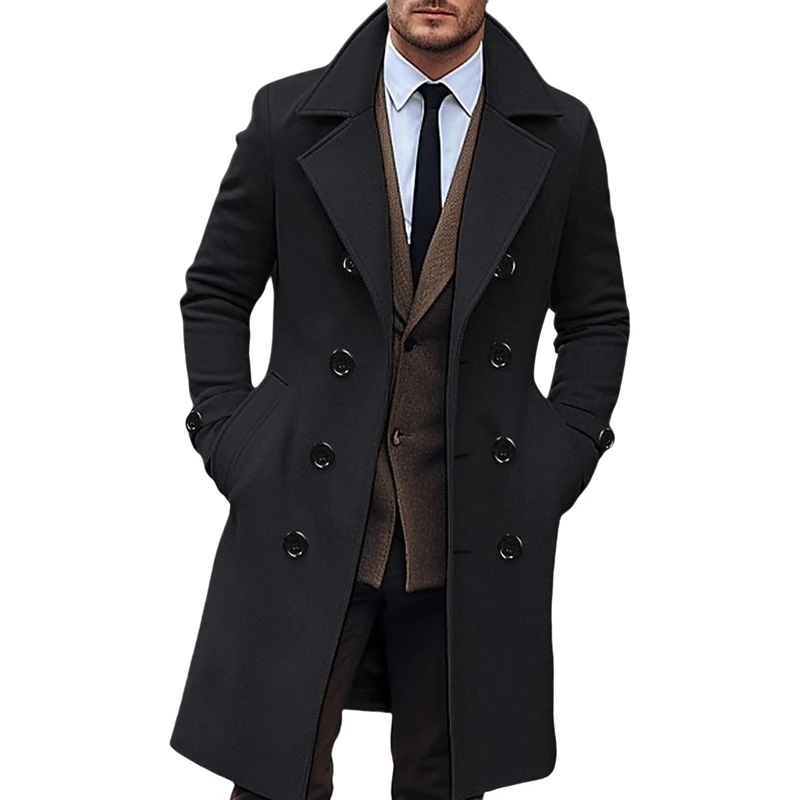
The Contemporary Relevance: Why Herringbone Endures in Modern Menswear
In an era of fast fashion and rapidly shifting trends, the enduring popularity of herringbone stands as testament to some deeper principles at work in menswear. This classic pattern continues to captivate contemporary men for reasons that transcend mere aesthetics.
The herringbone pattern possesses a remarkable duality that few other designs can match. It simultaneously embodies heritage and modernity, formality and approachability. This versatility allows herringbone to adapt to changing fashion landscapes without ever appearing outdated or irrelevant. While cuts and silhouettes may evolve, the pattern itself maintains its fundamental appeal.
Perhaps most significantly, herringbone bridges formality levels with unparalleled ease. The same pattern that adorns boardroom-appropriate overcoats can appear equally at home in casual weekend wear, merely by changing scale, color, or accompanying pieces. Few textile patterns offer such versatility across contexts and occasions. This adaptability makes wool overcoats with winter warmth particularly valuable as they transition between professional and personal settings with equal confidence.
Contemporary designers continue finding fresh expressions for this ancient pattern. Modern interpretations include oversized herringbone for bold statements, miniaturized patterns for subtle texture, and experiments with color that move beyond traditional neutrals. Even as they innovate, these designers acknowledge herringbone’s fundamental characteristics that have proven successful for centuries.
The sustainability angle cannot be overlooked in evaluating herringbone’s contemporary relevance. In an increasingly environmentally-conscious world, investing in timeless patterns rather than seasonal trends represents responsible consumption. A quality herringbone coat might remain stylish and serviceable for decades—a sharp contrast to disposable fashion’s environmental toll.
Beyond practical considerations, herringbone contributes significantly to a sophisticated personal aesthetic. The pattern carries subtle connotations of education, refinement, and attention to detail without appearing ostentatious. It communicates intentionality in dressing—suggesting the wearer appreciates nuance and tradition while remaining engaged with contemporary style.
For the modern man navigating varied social contexts and dress codes, a herringbone coat represents more than just outerwear. It’s a versatile tool for personal expression that maintains relevance across seasons, occasions, and evolving fashion landscapes. This adaptability explains why, generation after generation, discerning gentlemen return to herringbone as a cornerstone of sophisticated wardrobes.

The coat that caught your grandfather’s eye still captures attention today—perhaps in a slimmer cut or paired with different accessories, but fundamentally unchanged in its essential appeal. Few garments can claim such timeless relevance, making the herringbone coat not merely a purchase but a genuine wardrobe investment.
At Metro Cloak, we understand that exceptional outerwear transcends trends. Our selection of herringbone coats embodies this philosophy, offering modern gentlemen access to this enduring classic reinterpreted for contemporary lives—without sacrificing the quality and character that have made herringbone a perpetual favorite among those who appreciate true style.

